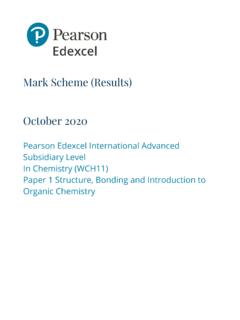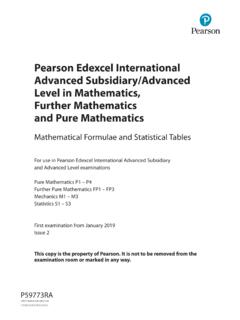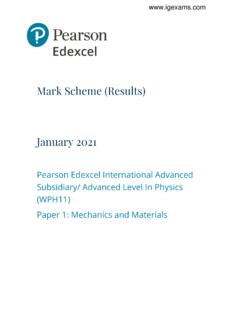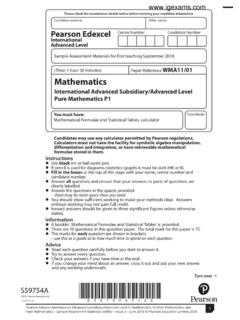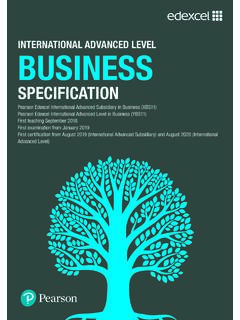Transcription of Mark Scheme (Results) January 2020
1 Mark Scheme (Results) January 2020 pearson international advanced subsidiary Level In Chemistry (WCH11) Paper 01 Structure, Bonding and Introduction to Organic Chemistry edexcel and BTEC Qualifications edexcel and BTEC qualifications are awarded by pearson , the UK s largest awarding body. We provide a wide range of qualifications including academic, vocational, occupational and specific programmes for employers. For further information visit our qualifications websites at or Alternatively, you can get in touch with us using the details on our contact us page at pearson : helping people progress, everywhere pearson aspires to be the world s leading learning company.
2 Our aim is to help everyone progress in their lives through education. We believe in every kind of learning, for all kinds of people, wherever they are in the world. We ve been involved in education for over 150 years, and by working across 70 countries, in 100 languages, we have built an international reputation for our commitment to high standards and raising achievement through innovation in education. Find out more about how we can help you and your students at: January 2020 Publications Code WCH11_01_2001_MS All the material in this publication is copyright pearson Education Ltd 2020 General Marking Guidance All candidates must receive the same treatment.
3 Examiners must mark the first candidate in exactly the same way as they mark the last. Mark schemes should be applied positively. Candidates must be rewarded for what they have shown they can do rather than penalised for omissions. Examiners should mark according to the mark Scheme not according to their perception of where the grade boundaries may lie. There is no ceiling on achievement. All marks on the mark Scheme should be used appropriately. All the marks on the mark Scheme are designed to be awarded.
4 Examiners should always award full marks if deserved, if the answer matches the mark Scheme . Examiners should also be prepared to award zero marks if the candidate s response is not worthy of credit according to the mark Scheme . Where some judgement is required, mark schemes will provide the principles by which marks will be awarded and exemplification may be limited. When examiners are in doubt regarding the application of the mark Scheme to a candidate s response, the team leader must be consulted. Crossed out work should be marked UNLESS the candidate has replaced it with an alternative response.
5 Using the Mark Scheme Examiners should look for qualities to reward rather than faults to penalise. This does NOT mean giving credit for incorrect or inadequate answers, but it does mean allowing candidates to be rewarded for answers showing correct application of principles and knowledge. Examiners should therefore read carefully and consider every response: even if it is not what is expected it may be worthy of credit. The mark Scheme gives examiners: an idea of the types of response expected how individual marks are to be awarded the total mark for each question examples of responses that should NOT receive credit.
6 / means that the responses are alternatives and either answer should receive full credit. ( ) means that a phrase/word is not essential for the award of the mark, but helps the examiner to get the sense of the expected answer. Phrases/words in bold indicate that the meaning of the phrase or the actual word is essential to the answer. ecf/TE/cq (error carried forward) means that a wrong answer given in an earlier part of a question is used correctly in answer to a later part of the same question. Candidates must make their meaning clear to the examiner to gain the mark.
7 Make sure that the answer makes sense. Do not give credit for correct words/phrases which are put together in a meaningless manner. Answers must be in the correct context. Section A Question Number Answer Mark 1 The only correct answer is C (17 protons, 20 neutrons, 18 electrons) A is incorrect because this shows the subatomic particles in 37Cl+ ion B is incorrect because this is for a chlorine-37 atom D is incorrect because the proton and neutron numbers are reversed (1) Question Number Answer Mark 2 The only correct answer is A ( ) B is incorrect because this is the correct answer to 3 SF C is incorrect because a relative mass of 59 has been used for the first isotope and the answer is to 3 SF D is incorrect because a relative mass of 59 has been used for the first isotope (1) Question Number Answer Mark 3 The only correct answer is D (14) A is incorrect because 3 is the number of quantum shells B is incorrect because 6 is the total number of subshells C is incorrect because 9 is the number of orbitals in the third quantum shell (1)
8 Question Number Answer Mark 4 The only correct answer is B (carbon) A is incorrect because lithium is an s-block element with one unpaired electron C is incorrect because fluorine is a p-block element with one unpaired electron D is incorrect because titanium is a d-block element with two unpaired electrons (1) Question Number Answer Mark 5 The only correct answer is C (aluminium) A is incorrect because there would not be a large jump between the third and fourth ionisations B is incorrect because there would not be a large jump between the third and fourth ionisations D is incorrect because there would not be a large jump between the third and fourth ionisations (1) Question Number Answer Mark 6 The only correct answer is D ( )
9 A is incorrect because this is the relative formula mass of anhydrous barium hydroxide B is incorrect because the relative masses of 8H2 and O have been added instead of 8H2O C is incorrect because an Mr value of 16 has been used for water (1) Question Number Answer Mark 7 The only correct answer is C ( ) A is incorrect because the volume has not been converted to dm3 B is incorrect because the volume has been divided by the amount of sodium sulfate D is incorrect because the volume has not been converted to dm3 and the volume has been divided by the amount (1) Question Number Answer Mark 8 The only correct answer is B (MgO) A is incorrect because the ion charges are +1 and 1 C is incorrect because the ion charges are +1 and 1 and the ionic radii are larger D is incorrect because the ionic radii are larger (1)
10 Question Number Answer Mark 9 The only correct answer is B (MgI2) A is incorrect because fluoride ions are not as easily polarised as iodide ions C is incorrect because barium ions are less polarising than magnesium and fluoride ions are not easily polarised D is incorrect because barium ions are less polarising than magnesium ions (1) Question Number Answer Mark 10(a) The only correct answer is D (white precipitate) A is incorrect because the reactants are colourless B is incorrect because no gas is given off C is incorrect because a precipitate forms (1) Question Number Answer Mark 10(b) The only correct answer is C (Ba2+(aq) + SO42 (aq) BaSO4(s)) A is incorrect because the ion charges are not +1 and 1 B is incorrect because the equation does not represent the formation of a precipitate D is incorrect because the spectator ions have not been cancelled (1) Question Number Answer Mark 10(c) The only correct answer is C ( g)
